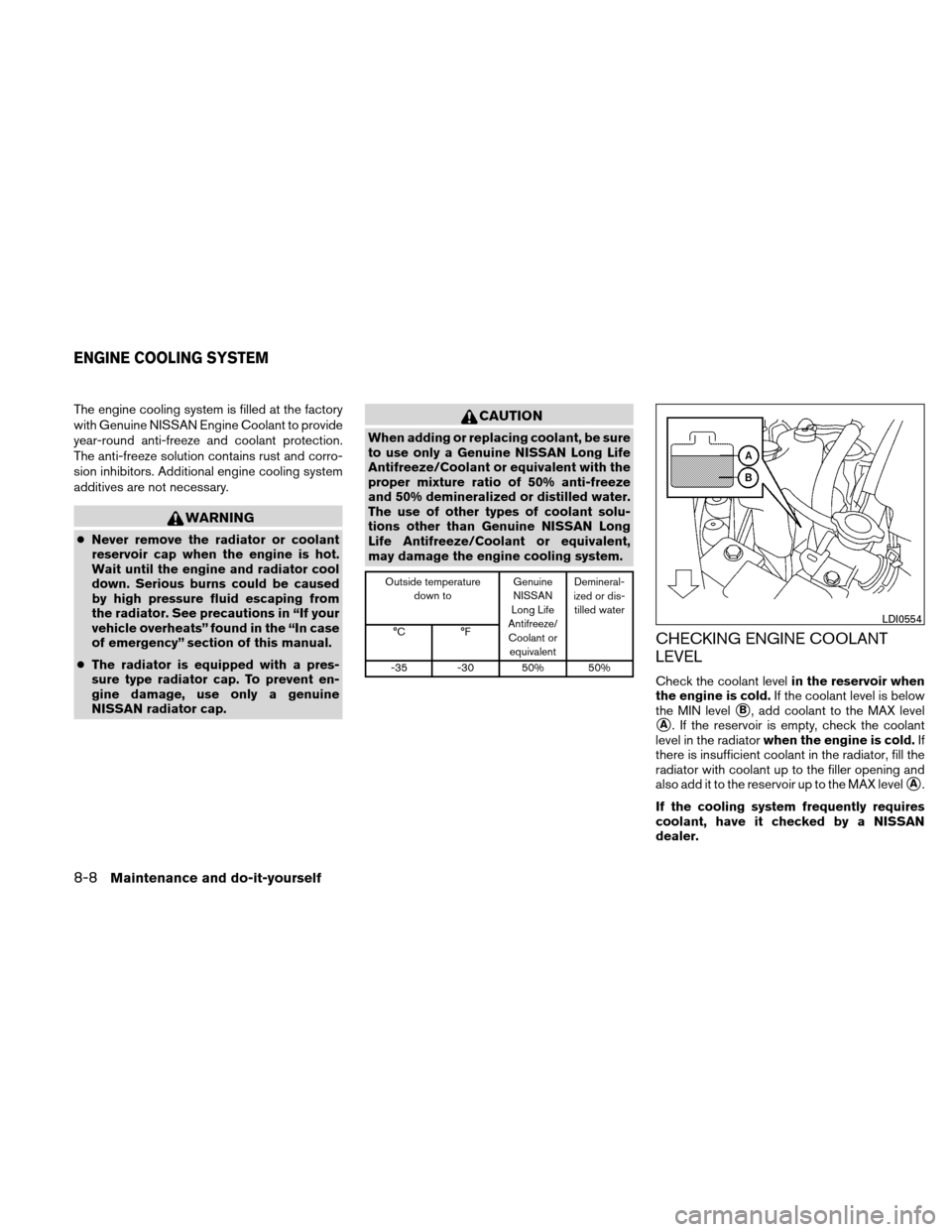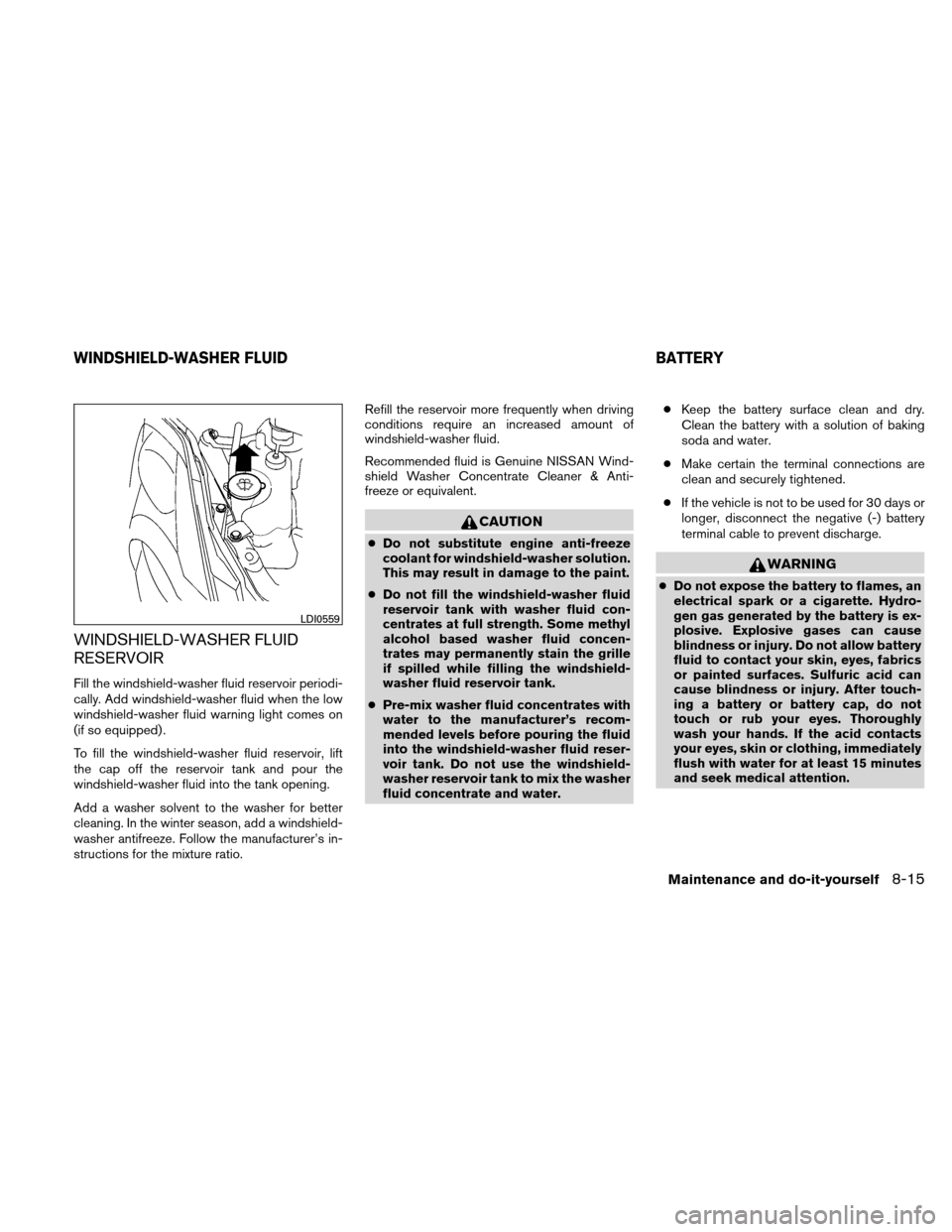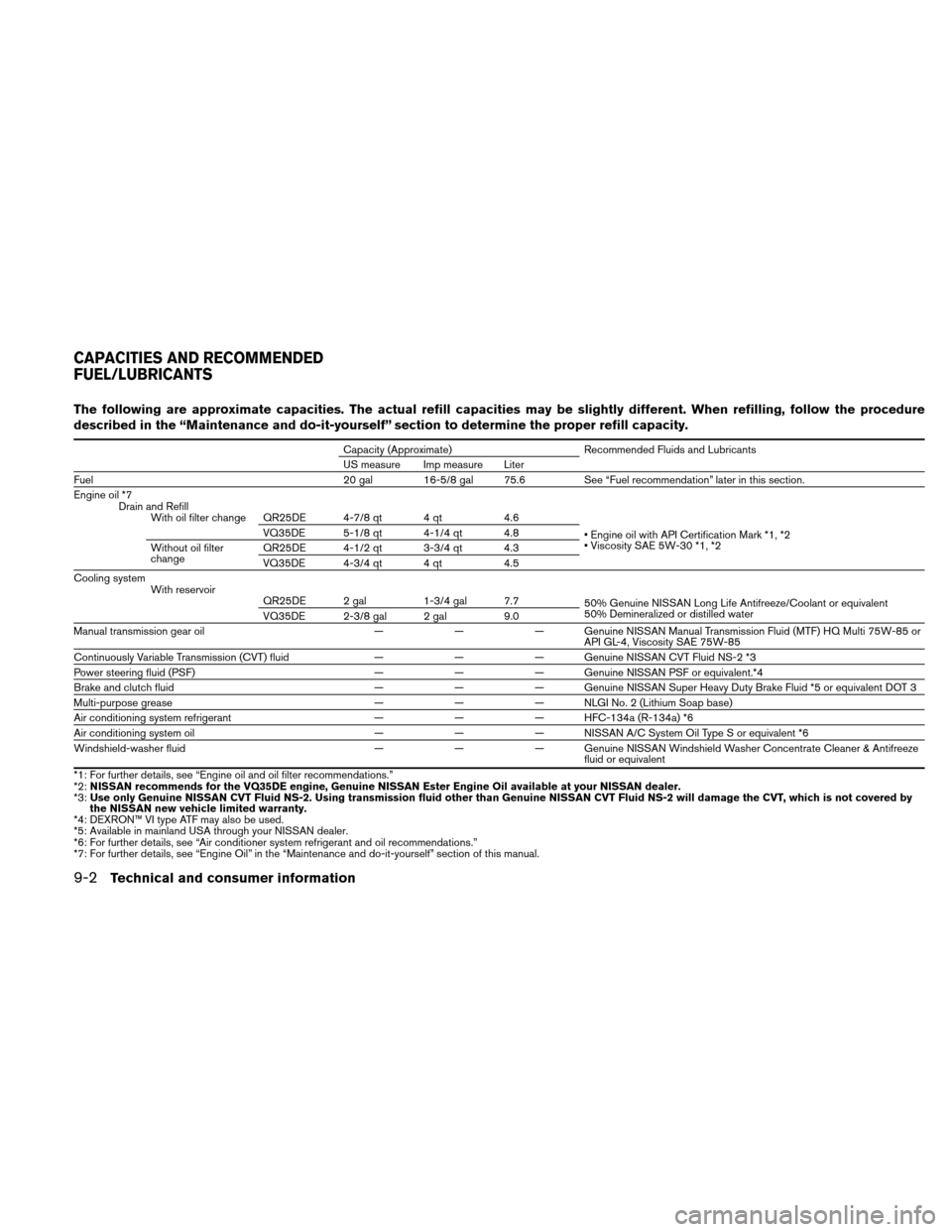Page 365 of 440

The engine cooling system is filled at the factory
with Genuine NISSAN Engine Coolant to provide
year-round anti-freeze and coolant protection.
The anti-freeze solution contains rust and corro-
sion inhibitors. Additional engine cooling system
additives are not necessary.
WARNING
●Never remove the radiator or coolant
reservoir cap when the engine is hot.
Wait until the engine and radiator cool
down. Serious burns could be caused
by high pressure fluid escaping from
the radiator. See precautions in “If your
vehicle overheats” found in the “In case
of emergency” section of this manual.
● The radiator is equipped with a pres-
sure type radiator cap. To prevent en-
gine damage, use only a genuine
NISSAN radiator cap.
CAUTION
When adding or replacing coolant, be sure
to use only a Genuine NISSAN Long Life
Antifreeze/Coolant or equivalent with the
proper mixture ratio of 50% anti-freeze
and 50% demineralized or distilled water.
The use of other types of coolant solu-
tions other than Genuine NISSAN Long
Life Antifreeze/Coolant or equivalent,
may damage the engine cooling system.
Outside temperature
down to Genuine
NISSAN
Long Life
Antifreeze/ Coolant or equivalent Demineral-
ized or dis- tilled water
°C °F
-35 -30 50% 50%
CHECKING ENGINE COOLANT
LEVEL
Check the coolant level in the reservoir when
the engine is cold. If the coolant level is below
the MIN level
�B, add coolant to the MAX level
�A. If the reservoir is empty, check the coolant
level in the radiator when the engine is cold. If
there is insufficient coolant in the radiator, fill the
radiator with coolant up to the filler opening and
also add it to the reservoir up to the MAX level
�A.
If the cooling system frequently requires
coolant, have it checked by a NISSAN
dealer.
LDI0554
ENGINE COOLING SYSTEM
8-8Maintenance and do-it-yourself
Page 372 of 440

WINDSHIELD-WASHER FLUID
RESERVOIR
Fill the windshield-washer fluid reservoir periodi-
cally. Add windshield-washer fluid when the low
windshield-washer fluid warning light comes on
(if so equipped) .
To fill the windshield-washer fluid reservoir, lift
the cap off the reservoir tank and pour the
windshield-washer fluid into the tank opening.
Add a washer solvent to the washer for better
cleaning. In the winter season, add a windshield-
washer antifreeze. Follow the manufacturer’s in-
structions for the mixture ratio.Refill the reservoir more frequently when driving
conditions require an increased amount of
windshield-washer fluid.
Recommended fluid is Genuine NISSAN Wind-
shield Washer Concentrate Cleaner & Anti-
freeze or equivalent.
CAUTION
●
Do not substitute engine anti-freeze
coolant for windshield-washer solution.
This may result in damage to the paint.
● Do not fill the windshield-washer fluid
reservoir tank with washer fluid con-
centrates at full strength. Some methyl
alcohol based washer fluid concen-
trates may permanently stain the grille
if spilled while filling the windshield-
washer fluid reservoir tank.
● Pre-mix washer fluid concentrates with
water to the manufacturer’s recom-
mended levels before pouring the fluid
into the windshield-washer fluid reser-
voir tank. Do not use the windshield-
washer reservoir tank to mix the washer
fluid concentrate and water. ●
Keep the battery surface clean and dry.
Clean the battery with a solution of baking
soda and water.
● Make certain the terminal connections are
clean and securely tightened.
● If the vehicle is not to be used for 30 days or
longer, disconnect the negative (-) battery
terminal cable to prevent discharge.
WARNING
● Do not expose the battery to flames, an
electrical spark or a cigarette. Hydro-
gen gas generated by the battery is ex-
plosive. Explosive gases can cause
blindness or injury. Do not allow battery
fluid to contact your skin, eyes, fabrics
or painted surfaces. Sulfuric acid can
cause blindness or injury. After touch-
ing a battery or battery cap, do not
touch or rub your eyes. Thoroughly
wash your hands. If the acid contacts
your eyes, skin or clothing, immediately
flush with water for at least 15 minutes
and seek medical attention.
LDI0559
WINDSHIELD-WASHER FLUID BATTERY
Maintenance and do-it-yourself8-15
Page 405 of 440

The following are approximate capacities. The actual refill capacities may be slightly different. When refilling, follow the procedure
described in the “Maintenance and do-it-yourself” section to determine the proper refill capacity.
Capacity (Approximate)Recommended Fluids and Lubricants
US measure Imp measure Liter
Fuel 20 gal 16-5/8 gal 75.6See “Fuel recommendation” later in this section.
Engine oil *7 Drain and RefillWith oil filter change QR25DE 4-7/8 qt 4 qt 4.6
Engine oil with API Certification Mark *1, *2
Viscosity SAE 5W-30 *1, *2
VQ35DE 5-1/8 qt 4-1/4 qt 4.8
Without oil filter
change QR25DE 4-1/2 qt 3-3/4 qt 4.3
VQ35DE 4-3/4 qt 4 qt
4.5
Cooling system With reservoir QR25DE 2 gal 1-3/4 gal 7.7
50% Genuine NISSAN Long Life Antifreeze/Coolant or equivalent
50% Demineralized or distilled water
VQ35DE 2-3/8 gal 2 gal 9.0
Manual transmission gear oil ——— Genuine NISSAN Manual Transmission Fluid (MTF) HQ Multi 75W-85 or
API GL-4, Viscosity SAE 75W-85
Continuously Variable Transmission (CVT) fluid ——— Genuine NISSAN CVT Fluid NS-2 *3
Power steering fluid (PSF) ——— Genuine NISSAN PSF or equivalent.*4
Brake and clutch fluid ——— Genuine NISSAN Super Heavy Duty Brake Fluid *5 or equivalent DOT 3
Multi-purpose grease ——— NLGI No. 2 (Lithium Soap base)
Air conditioning system refrigerant ——— HFC-134a (R-134a) *6
Air conditioning system oil ——— NISSAN A/C System Oil Type S or equivalent *6
Windshield-washer fluid ——— Genuine NISSAN Windshield Washer Concentrate Cleaner & Antifreeze
fluid or equivalent
*1: For further details, see “Engine oil and oil filter recommendations.”
*2: NISSAN recommends for the VQ35DE engine, Genuine NISSAN Ester Engine Oil available at your NISSAN dealer.
*3: Use only Genuine NISSAN CVT Fluid NS-2. Using transmission fluid other than Genuine NISSAN CVT Fluid NS-2 will damage the CVT, which is not covered by
the NISSAN new vehicle limited warranty.
*4: DEXRON™ VI type ATF may also be used.
*5: Available in mainland USA through your NISSAN dealer.
*6: For further details, see “Air conditioner system refrigerant and oil recommendations.”
*7: For further details, see “Engine Oil” in the “Maintenance and do-it-yourself” section of this manual.
CAPACITIES AND RECOMMENDED
FUEL/LUBRICANTS
9-2Technical and consumer information